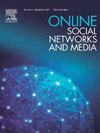推特上的政治交流和阴谋论分享
IF 2.9
Q1 Social Sciences
引用次数: 0
摘要
社交媒体已经成为一个有影响力的政治沟通渠道,在提供广泛影响的同时,也使错误信息和阴谋论得以扩散。这些未经检查的阴谋叙事可能会被恶意行为者操纵,对民主进程构成威胁。尽管阴谋论在直觉上很有吸引力,但与错误信息和假新闻的传播相比,很少有研究调查阴谋论在政客社交媒体传播中的战略使用和时机。本研究对美国国会议员如何在Twitter上传播阴谋论进行了实证分析。利用推特历史API,我们收集了2012年1月至2022年12月期间美国国会议员的推文语料库。我们开发了一个分类器来识别这种政治话语中的阴谋论内容。我们还分析了阴谋推文的语言特征、话题和分布。为了评估分类器的性能,我们通过人工注释创建了基础事实数据,专家在其中标记了2500个政治家的推文样本。我们的研究结果揭示了几个方面,包括主流政治权力动态对阴谋论传播和更高用户参与度的影响。此外,我们确定了推文中特定的心理语言属性,其特征是使用与权力和因果关系以及外群体语言相关的词语。我们的研究结果为有影响力的人物参与政治话语中阴谋叙事传播的动机提供了有价值的见解。本文章由计算机程序翻译,如有差异,请以英文原文为准。
Political communication and conspiracy theory sharing on twitter
Social media has become an influential channel for political communication, offering broad reach while enabling the proliferation of misinformation and conspiracy theories. These unchecked conspiracy narratives may allow manipulation by malign actors, posing dangers to democratic processes. Despite their intuitive appeal, little research has examined the strategic usage and timing of conspiracy theories in politicians’ social media communication compared to the spread of misinformation and fake news.
This study provides an empirical analysis of how members of the U.S. Congress spread conspiracy theories on Twitter. Leveraging the Twitter Historical API, we collected a corpus of tweets from members of the US Congress between January 2012 and December 2022. We developed a classifier to identify conspiracy theory content within this political discourse. We also analyzed the linguistic characteristics, topics and distribution of conspiracy tweets. To assess classifier performance, we created ground truth data through human annotation in which experts labeled a sample of 2500 politicians’ tweets.
Our findings shed light on several aspects, including the influence of prevailing political power dynamics on the propagation of conspiracy theories and higher user engagement. Moreover, we identified specific psycho-linguistic attributes within the tweets, characterized by the use of words related to power and causation, and outgroup language. Our results provide valuable insights into the motivations compelling influential figures to engage in the dissemination of conspiracy narratives in political discourse.
求助全文
通过发布文献求助,成功后即可免费获取论文全文。
去求助
来源期刊

Online Social Networks and Media
Social Sciences-Communication
CiteScore
10.60
自引率
0.00%
发文量
32
审稿时长
44 days
 求助内容:
求助内容: 应助结果提醒方式:
应助结果提醒方式:


